

Spark SQL and DataFrames - Spark 1.6.1 Documentation. Spark SQL is a Spark module for structured data processing.
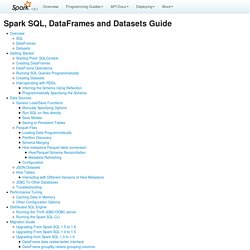
Unlike the basic Spark RDD API, the interfaces provided by Spark SQL provide Spark with more information about the structure of both the data and the computation being performed. Internally, Spark SQL uses this extra information to perform extra optimizations. There are several ways to interact with Spark SQL including SQL, the DataFrames API and the Datasets API. When computing a result the same execution engine is used, independent of which API/language you are using to express the computation. This unification means that developers can easily switch back and forth between the various APIs based on which provides the most natural way to express a given transformation.
All of the examples on this page use sample data included in the Spark distribution and can be run in the spark-shell, pyspark shell, or sparkR shell. Mikeaddison93/spark-csv: CSV data source for Spark SQL and DataFrames. Complex Event Processing using Spark Streaming and SparkSQL. Introduction Apache Spark has come a long way in just the last year.
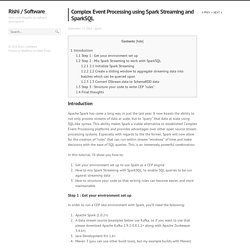
It now boasts the ability to not only process streams of data at scale, but to “query” that data at scale using SQL-like syntax. This ability makes Spark a viable alternative to established Complex Event Processing platforms and provides advantages over other open source stream processing systems. Especially with regards to the the former, Spark will now allow for the creation of “rules” that can run within stream “windows” of time and make decisions with the ease of SQL queries. This is an immensely powerful combination. In this tutorial, I’ll show you how to: Get your environment set up to use Spark as a CEP engineHow to mix Spark Streaming with SparkSQL, to enable SQL queries to be run against streaming dataHow to structure your code so that writing rules can become easier, and more maintainable Step 1 : Get your environment set up In order to run a CEP like environment with Spark, you’ll need the following:
Run Spark and Spark SQL on Amazon Elastic MapReduce : Articles & Tutorials : Amazon Web Services. With the proliferation of data today, a common scenario is the need to store large data sets, process that data set iteratively, and discover insights using low-latency relational queries.
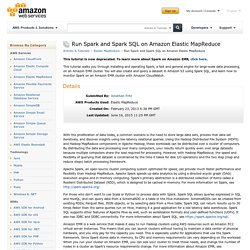
Using the Hadoop Distributed File System (HDFS) and Hadoop MapReduce components in Apache Hadoop, these workloads can be distributed over a cluster of computers. By distributing the data and processing over many computers, your results return quickly even over large datasets because multiple computers share the load required for processing. However, with Hadoop MapReduce, the speed and flexibility of querying that dataset is constrained by the time it takes for disk I/O operations and the two step (map and reduce steps) batch processing framework. Apache Spark, an open-source cluster computing system optimized for speed, can provide much faster performance and flexibility than Hadoop MapReduce. Spark: Connecting to a jdbc data-source using dataframes. So far in Spark, JdbcRDD has been the right way to connect with a relational data source.
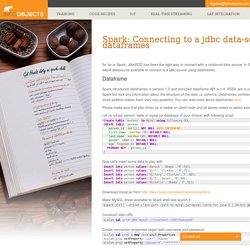
In Spark 1.4 onwards there is an inbuilt datasource available to connect to a jdbc source using dataframes. Spark introduced dataframes in version 1.3 and enriched dataframe API in 1.4. RDDs are a unit of compute and storage in Spark but lack any information about the structure of the data i.e. schema. Dataframes combine RDDs with Schema and this small addition makes them very very powerful. You can read more about dataframes here. Please make sure that jdbc driver jar is visible on client node and all slaves nodes on which executor will run. Let us create ‘person’ table in mysql (or database of your choice) with following script: Now Let’s insert some data to play with Download mysql jar from. GitHub - mikeaddison93/spark-csv: CSV data source for Spark SQL and DataFrames. Spark SQL Programming Guide - Spark 1.1.0 Documentation. Spark SQL allows relational queries expressed in SQL, HiveQL, or Scala to be executed using Spark.
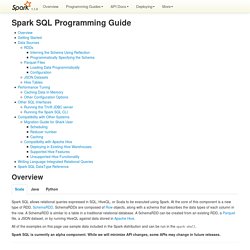
At the core of this component is a new type of RDD, SchemaRDD. SchemaRDDs are composed of Row objects, along with a schema that describes the data types of each column in the row. A SchemaRDD is similar to a table in a traditional relational database. A SchemaRDD can be created from an existing RDD, a Parquet file, a JSON dataset, or by running HiveQL against data stored in Apache Hive. Blazegraph. GraphVizdb - Semantic Web Standards. Mikeaddison93/sparql-playground. Spark SQL and DataFrames - Spark 1.5.2 Documentation. Learning SPARQL. RDFSharp - Semantic Web Standards. (Tool description last modified on 2015-09-7.)
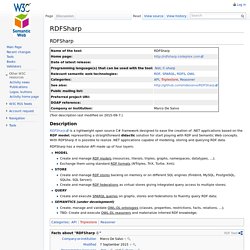
Description RDFSharp is a lightweight open source C# framework designed to ease the creation of .NET applications based on the RDF model, representing a straightforward didactic solution for start playing with RDF and Semantic Web concepts. With RDFSharp it is possible to realize .NET applications capable of modeling, storing and querying RDF data. RDFSharp has a modular API made up of four layers: SPARQL - Semantic Web Standards. Overview RDF is a directed, labeled graph data format for representing information in the Web.
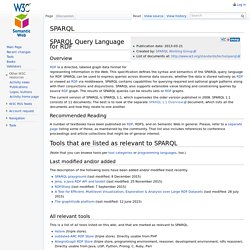
This specification defines the syntax and semantics of the SPARQL query language for RDF. SPARQL can be used to express queries across diverse data sources, whether the data is stored natively as RDF or viewed as RDF via middleware. SPARQL contains capabilities for querying required and optional graph patterns along with their conjunctions and disjunctions. SPARQL also supports extensible value testing and constraining queries by source RDF graph. The current version of SPARQL is SPARQL 1.1, which supersedes the older version published in 2008. Recommended Reading A number of textbooks have been published on RDF, RDFS, and on Semantic Web in general. (Note that you can browse tools per tool categories or programming languages, too.) Last modified and/or added The description of the following tools have been added and/or modified most recently. All relevant tools 4store (triple store). SPARQL Query Language for RDF.
W3C Recommendation 15 January 2008 New Version Available: SPARQL 1.1 (Document Status Update, 26 March 2013) The SPARQL Working Group has produced a W3C Recommendation for a new version of SPARQL which adds features to this 2008 version.
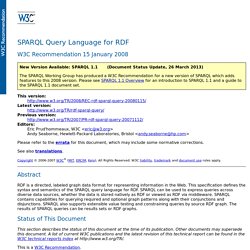
Please see SPARQL 1.1 Overview for an introduction to SPARQL 1.1 and a guide to the SPARQL 1.1 document set. This version: Latest version: Previous version: SPARQLer - An RDF Query Server.